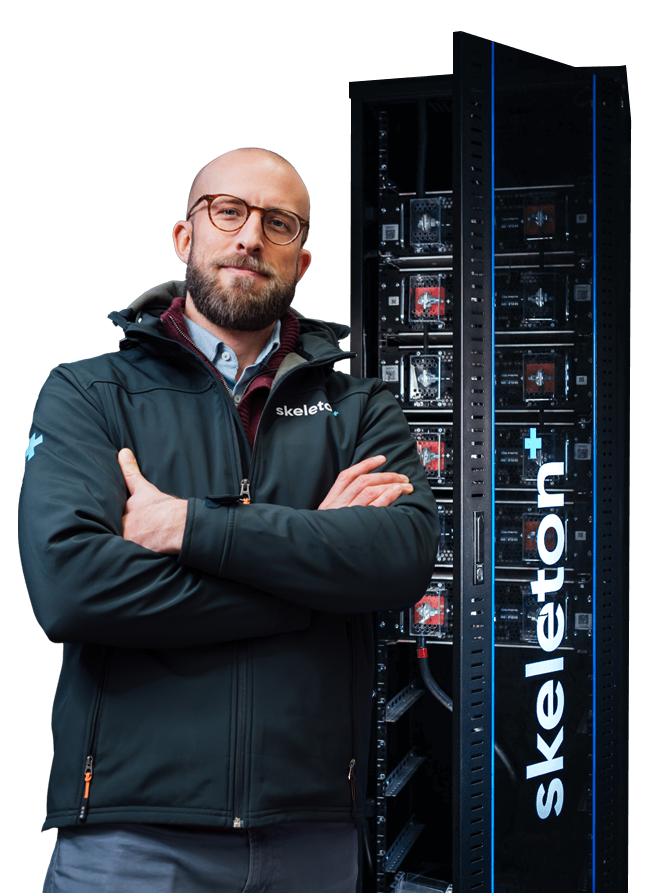
Why Innovation Needs to Be the Top Priority in Europe’s Raw Material Strategy

Arnaud Castaignet, Skeleton's Vice President of Government Affairs and Public Relations, provides context on the recent report titled “Doing More with Less: A European Critical Raw Materials Strategy Fit for Cleantech Competitiveness” by Cleantech for Europe, a report to which the company contributed."
Why did Skeleton participate in the preparation of this report?
As one of Europe’s leading scale-ups, Skeleton Technologies holds membership in Cleantech for Europe. This organization stands as the voice of the cleantech sector to European institutions. With the backing of Bill Gates’ Breakthrough Energy, Cleantech for Europe represents companies that are at the forefront of developing, deploying, and investing in clean technologies across the EU. It plays the important role of providing policymakers with cleantech insights. Our participation in Cleantech for Europe’s initiatives includes contributing to reports, position papers, and voicing our perspectives on pivotal European policies, such as the Net Zero Industry Act (NZIA), Strategic Technologies for Europe Platform (STEP), and Critical Raw Materials Act (CRMA). Fellow members include the likes of Verkor, Hydrovolt, H2Green Steel, Volta Trucks and many others.

Arnaud Castaignet
The Critical Raw Materials Act, a cornerstone of the Green Deal Industrial Plan, aims to secure the EU's access to diverse, affordable, and sustainable raw materials, a vital step towards achieving its climate and digital objectives. This act was introduced alongside the Commission’s proposal for the Net Zero Industry Act, geared towards amplifying the production of essential carbon-neutral technologies for clean energy supply chains. Cleantech for Europe has highlighted certain gaps in the Commission’s proposal, notably its insufficient emphasis on cleantech innovation. The EU's strategy shouldn’t solely focus on supply security. It's imperative not to overlook innovation, the pivotal backbone of its critical raw materials strategy. This underlines the rationale behind Cleantech for Europe's latest report, which incorporates insights from its member companies.
Skeleton Technologies is very much involved in discussions surrounding critical raw materials, and for good reasons. Unlike many energy storage solutions, our supercapacitors do not rely on nickel or cobalt. Our patented Curved Graphene material offers an alternative to some of the critical raw materials prevalent in the battery industry. By incorporating Curved Graphene, there's potential to either reduce the dependency on these CRMs or amplify the efficiency and longevity of energy storage devices, which in turn diminishes their carbon footprint. Importantly, the production and utilization of Curved Graphene hinge on materials that are abundantly available within Europe. This positions us at the forefront of efforts to minimize Europe's dependence on critical raw materials sourced from outside its borders.
We clearly stand for the development of alternatives to the most common critical raw materials used in the battery industry. We believe that recycling and creating substitutes for these materials are essential for Europe's future. Such an approach not only addresses sustainability but also offers companies like ours a unique selling point, enhancing our global competitiveness.
Skeleton serves as a prime example of this, especially with our Bitterfeld-Wolfen-based subsidiary, Skeleton Materials. Several European scale-ups in different sectors are also making strides. Take, for example, Latvia-based Naco Technologies: they're pioneering a nano-coating technology that not only increases the efficiency and lifespan of critical components in electrolyzers and fuel cells but also reduces the need for iridium and platinum.
The CRMA will likely usher in a resurgence of exploration and mining in Europe. In this context, we champion incentives that promote more sustainable mining practices. This includes using technologies to electrify mining equipment and decrease both environmental impact and local resistance to such projects. As highlighted in the report, our SuperBattery is used for decarbonizing heavy-duty vehicles in the mining sector. This is where traditional lithium-ion batteries fall short due to longer charging times, fewer life cycles, and insufficient power density.
What sets this report apart in terms of its relevance and significance?
The report prioritizes innovation over security of supply and includes proposals to increase funding. Only with a clear innovation strategy and sufficient funding can the EU achieve its long-term goals.
While it's important to secure supply through partnerships with mining companies and mineral-rich nations, this approach cannot form the sole foundation of Europe’s strategy. Consider cobalt, used in both batteries and aircraft turbines. Currently, the EU is reliant on imports for over 80% of its cobalt needs, with half of this supply originating from the Democratic Republic of the Congo —a country that commands a dominant position in the global cobalt market. While Finland and French Guiana contribute minor amounts, there's significant room to augment domestic production or even diversify imports, possibly from countries like Canada. However, if innovation offers avenues to reduce or offset Europe’s dependence on cobalt, such opportunities must be pursued.
Rare earths further illustrate this point. These are indispensable for crafting permanent magnets, which find applications in everyday devices like smartphones, TVs, and computers, as well as in electrolysers critical for green hydrogen production. Currently, China is supplying nearly 99% of the EU’s rare earth minerals and about 98% of its rare earth permanent magnets. Europe’s largest-known deposit of rare earths is in northern Sweden, but it could take 10-15 years for extraction to begin. This underscores the paramount importance of innovation. A case in point is the Germany-based Sunfire, which manufactures an electrolyser that bypasses the need for rare earths. While it necessitates scandium, the EU sources a significant 98% of this element from the U.K., our key ally and partner.
Cleantech for Europe Report: “Doing More with Less: A European Critical Raw Materials Strategy Fit for Cleantech Competitiveness” – in a nutshell:
The European Union, under the EU Green Deal, is ambitiously transforming its energy, transportation, and technological sectors. Central to this transition are critical raw materials (CRMs) like lithium and cobalt, which are vital for technological advancements but face significant supply risks due to geographic supply concentrations and a lack of substitutes. Any disruption in the CRM chain could compromise the EU's green and digital agendas. However, innovative clean technologies offer prospects to lessen CRM dependency and foster sustainability. While the EU prioritizes supply security through various strategies like accelerated permitting and partnerships with mineral-rich nations, it underutilizes a crucial aspect: innovation.
This report emphasizes that focusing on cleantech innovation can pivot the EU's CRM dependency into an asset, promoting material efficiency and long-term supply security. Global policy initiatives, including the EU's Batteries Regulation and the Critical Raw Materials Act, have spurred investment in CRM-focused startups. In 2022, CRM startups secured a notable 160% year-over-year increase in funding, but a regional analysis reveals Europe lagging in cutting-edge CRM cleantech investment, especially when compared to North America in areas like battery recycling. The report advocates for targeted funding and regulatory support to maximize the cleantech economy and minimize CRM uncertainties.
Recommendations for an EU Cleantech Strategy for Critical Raw Materials:
Proposal 1: EU Public Funding Enhancement
- Address the investment disparity between the Net Zero Industry Act and the CRMA.
- Use the expanded EU Innovation Fund for CRM-cleantech projects and consider the European Hydrogen Bank model for swift project scaling.
- Create a European Critical Minerals Fund, emphasizing speed, scale, and simplicity, to back European CRM innovators. This fund might later benefit from the EU Carbon Border Adjustment Mechanism (CBAM) revenues.
Proposal 2: Boost CRM Supply through Clean Technologies
- Exploration: Direct EU nations to launch national CRM exploration programs and mandate significant mining firms to reveal their ecological footprints.
- Mining: Increase sustainable mining incentives, advocate for eco-friendly mining practices, and enforce the usage of electric mining equipment. Develop a “responsible mining” standard.
- Processing: Set standards to diminish waste and harmful chemicals in processing, alongside enhancing water efficiency. Public funds should stimulate private investment in eco-friendly and efficient CRM processing methods.
Proposal 3: Promote Technologies Limiting Primary CRM Demand
- Recycling: Standardize waste management for CRM-rich waste streams. Retain end-of-life batteries within Europe and enforce traceability for all material suppliers, not just battery manufacturers.
- Substitution: Drive investments in alternative materials to decrease mineral dependence in green tech. Amplify public backing for R&D projects, specifically those targeting CRM reduction in processes like electrolysis.
- Ecodesign: Investigate mature and emerging clean tech for ecodesign opportunities. EU must aggressively fund R&D into ecodesign approaches, especially those focused on creating recyclable materials.





